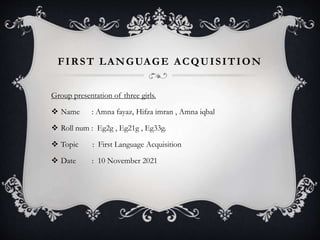
First language acquisition
- 1. FIRST LANGUAGE ACQUISITION Group presentation of three girls. Name : Amna fayaz, Hifza imran , Amna iqbal Roll num : Eg2g , Eg21g , Eg33g. Topic : First Language Acquisition Date : 10 November 2021
- 2. FIRST LANGUAGE ACQUISITION It Refers to first-language acquisition, which studies infants' acquisition of their native language. OR This is the acquisition of the mother tongue.
- 3. INPUT Input is where human infants are certainly helped in their language acquisition by the adults in the home environment.. Example: “tummy” , “mama” “poo-poo” “pee-pee” and others.
- 4. CAREGIVER SPEECH Also described as “motherese” or “child- directed speech”. The simplified and repetitive type of speech, with exaggerated intonation and rhythm, often used by adults when speaking to babies. Example: tata (give me), boo-boo (wound, hurt), moo moo (cow), num num (eat), etc
- 5. THE AC QUISITION STAGES There are Five main stages. Cooing Babbling The one- word stage The two- word stage Telegraphic speech
- 6. COOING Between 2-4 months. The child gradually becomes capable of producing vowel- like sounds, such as [i] and [u] Repetition of the vowel sounds. Express satisfaction or pleasure.
- 7. BABBLING Between 6-8 months. The child produces a number of different vowels and consonants, such as ba-ba-ba and ba-ba-da-da, which at times can almost sound like a real speech.
- 8. THE ONE-WORD STAGE Between 12 – 18 months. One or two recognizable word. Resembles words or simple phrases. Words that utter everyday objects such as “milk” , “cat” , “spoon”
- 9. THE TWO-WORD STAGE Between approximately 18 and 24 months of age. during which children use two words at a time when speaking. Example: dog bone, mama cup, more milk.
- 10. TELEGRAPHIC SPEECH Between 2 – 3 years old. The child begins producing a large number that could be classified as “multiple-word” speech. The child vocabulary has grown to hundreds of words during this stage and pronunciation become more clearer. Example; ‘Mummy eat lunch’
- 11. THE ACQUISITION PROCESS There are five processes of Acquisition. Learning through imitation Learning through correction Developing morphology Developing syntax Developing semantics
- 12. LEARNING THROUGH IMITATION Imitation helps toddlers firm up their knowledge. Children may repeat single words or phrases, but not the sentences structures. It is likely that the children understand what are the sentences but they express what they understand by their own. Example: The dog is sleeping = dog sleep
- 13. LEARNING THROUGH CORRECTION “corrections” are a very effective determiner of how the child speaks. The child will continue to use a personally constructed form, despite the adult’s repetition of what the correct form should be.
- 14. Example : Child : My teacher holded the baby rabbits. Mother : Did you say your teacher held the baby rabbits? Child : Yes. Mother : Did you say she held them tightly? Child : No, she holded them loosely.
- 15. By the age of two and half years old child start using inflectional morphemes that serves us grammatical function of the nouns and verbs. Example : -ing, Mommy eating. The second morphological development is marking of regural plural with –s forms. Example: -s boys, girls.
- 16. OVERGENERALIZATION: The term overgeneralization is most often used in connection with language acquisition by children. For example, a young child may say "foots" instead of "feet," overgeneralizing the morphological rule for making plural nouns.
- 17. DEVELOPING SYANTX In the formation of questions and the use of negatives. • The child goes through with 3 stages Stage 1 occurs between 18 – 26 months Stage 2 occurs between 22 - 30 months Stage 3 occurs between 24 - 40 months
- 18. STA GE 1 OCCUR S BETW EEN 18 – 26 MONTHS (Forming Question) Wh- form (Where, Who) to the beginning of the expression. Examples : Where mummy? Who is that person?
- 19. ( Forming Negatives) A simple strategy of putting NO or NOT at the beginning. Examples : not a teddy bear not sit here
- 20. STA GE 2 OCCUR S BETW EEN 22 - 30 MONTHS (Forming Question) More complex expressions can be formed. Wh-forms, such as What and Why. Examples : What is mummy doing? Why daddy is not home yet?
- 21. (Negative Forms ) “don’t” and “can’t” appear, and with no and not. Examples : He not bite you You cant dance
- 22. STA GE 3 OCCUR S BETW EEN 24 - 40 MONTHS The movement of the auxiliary in English questions (I can have… -> Can I have…?) Generally quite close to adult model. Examples : Can I have a piece? Will you help me?
- 23. (Forming Negative) Other auxiliary forms such as didn’t and won’t. Examples : I didn’t buy it. She won’t let go.
- 24. DEVELOPING SEMANTICS During the two-word stage, children use their limited vocabulary to refer to a large number of unrelated objects. Overextension : Overextend the meaning of a word on the basis of similarities of shape, sound and size. Example : use ball to refer an apple, an egg or a ball.